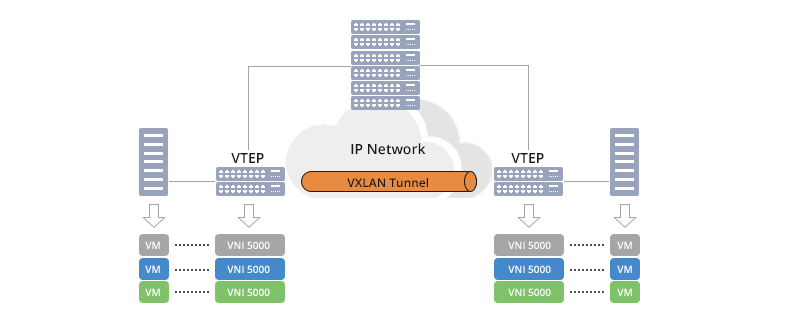VXLAN: the Future for Data Center Networks
Nowadays, the emergency and rapid development of new technologies, such as cloud computing, big data, and AI, are driving data centers to adopt virtualization technologies and increase their server virtualization to provide cloud services. Traditional VLAN links have been proven insufficient to cope with the requirements of cloud data centers for large scale and flexibility. Therefore, VXLAN came on the stage and has become a significant part of modern data center network architecture.
What Is VXLAN?
VXLAN (Virtual Extensible Local Area Network) is an overlay technology for network virtualization, which establishes a logical tunnel on the IP network to extend the Layer 2 network over an existing Layer 3 underlay network. VXLAN uses VXLAN Tunnel Endpoint (VTEP), which can be end hosts or network switches, or routers, to encapsulate and de-encapsulate layer 2 traffic.
VXLAN is designed to deliver reliable and scalable data center networking services to managed service customers and is a technology for next-generation data center construction.

What Problem Does VXLAN Solve?
VXLAN can offer the same services as VLAN but addresses scaling challenges in data center networks, especially a large Layer 2 network. As data centers scale up, tenants increase dramatically, requiring the isolation of massive tenants. Based on its unique design, VXLAN also addresses the requirements of a multi-tenant data center. The specific functions and important benefits of VXLAN are as follows.
-
Reduce the Number of MAC Addresses Learned by Devices
Except for VXLAN network edge devices, other devices in the network do not need to identify MAC addresses of virtual machines, which relieves the MAC address learning pressure of network devices, especially data center switches, and improves device performance.
-
More Logical Network Isolation
With a 24-bit segment ID known as the VXLAN network identifier (VNID), VXLAN supports up to 16 million VXLAN segments in an administrative domain(as opposed to 4094 VLANs). The isolation and identification of users are no longer limited, allowing data centers to accommodate a significant number of tenants.
-
Enable VM Migration on Large Layer 2 Networks
Using MAC-in-UDP encapsulation, VXLAN decouples the virtual network from the physical network, allowing dynamic allocation of resources within or between data centers. This enables the migration of virtual machines in large Layer 2 domains without regard to the restrictions of the broadcast domain and IP address in the physical network.

VXLAN to Build Data Center Networks
The development of server virtualization and cloud computing, as well as the rise of network convergence, have posed a requirement for faster and more efficient data center networks.Data centers in different industries are facing similar challenges. First, the traditional business resources dedicated leads to low utilization of existing hardware equipment resources. The physical devices are scattered and uneven, which makes it difficult to manage them uniformly. Second, the separate establishment of business systems leads to no information sharing, and the value of business data is basically "zero". Third, the business needs to be more agile, that is, rapid iterative development, update and upgrade, timely response to demand, and innovation acceleration. Fourth, the lack of unified automation tools for IT leads to low efficiency. VXLAN, as an advanced network virtualization technology, can effectively help to build data center networks.
Improved Network Performance
16 million VXLAN segments, far more than the 4,094 VLANs, enable massive inter-tenant isolation and allow data centers to handle a large amount of traffic in the cloud environment with sufficient links and capacity.
Moreover, VXLAN ensures a consistent network topology across the board, which reduces network complexity and improves network performance. Using VXLAN, data center networks can support large-scale deployments of cloud services and meet the needs of cloud data centers.
Great Data Center Scalability
VXLAN, combined with EVPN, can significantly increase data center network extension capability. EVPN-VXLAN even allows the extension of identical networks across multiple data centers through a single overlay, making them behave as one.
And hardware VTEPs minimize the latency overhead of VXLAN implementations, which helps build a scalable and robust data center network without sacrificing performance.
Increase Network Reliability
Once VXLAN gets to the access layer, it eliminates network outages and ensures uninterrupted server operation. And the configuration mode of VXLAN can dramatically reduce the possibility of making serious mistakes. You can also test any changes to the VXLAN in a virtual lab before putting it into use. With these features, VXLAN is beneficial to data center network reliability.
Simplify Network Management
VXLAN can use tunnels to build virtual Layer 2 networks over multiple Layer 3 networks, and virtual machines can migrate between different data centers, which makes the deployment of virtual machines more flexible and convenient. Therefore, VXLAN networks significantly simplify data center network management and configuration, and VXLAN provides multi-tiered network topology and enterprise-class security that can reduce deployment and provisioning time from weeks to small hours.
The Application Value of VXLAN
To sum up, the deployment advantages of VxLAN in the data center network architecture can provide you with greater business support. At the same time,it can also simplify network management, enabling IT personnel to conduct more effective network operation and maintenance. At present, FS has launched a cloud data center VxLAN solution with high performance, scalability characteristics, making full use of the VxLAN network protocol application advantages. In addition, the N-series data center switches are used to support this solution, such as the N5860-48SC and N8560-48BC, also have strong performance on top of VxLAN support.
You might be interested in
Email Address

-
PoE vs PoE+ vs PoE++ Switch: How to Choose?
Mar 16, 2023















